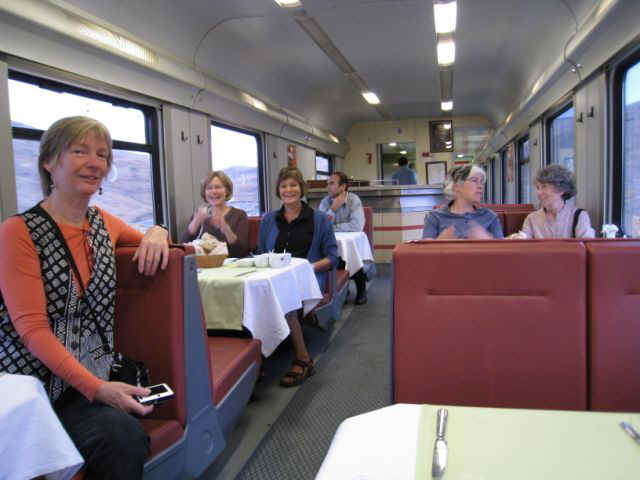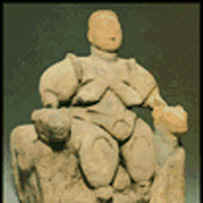Day 04 Saturday Sept. 27, 2008 ANKARA CAPPADOCIA Submitted by Dean
 Day 4 began on Istanbul’s overnight train to Ankara. The gentle rocking promoted a good night’s sleep for several of us – many of whom had timely noticed that there were conventional (i.e., non-Asian) toilets at the far end of our sleeper car. Some had been alerted to arise early to watch for Phrygian burial tumuli, and sure enough, there they were: pointy man-made hills barely illuminated by the emerging daylight. Upon arrival at Ankara’s RR station, we boarded the bus that would be with us for the rest of our stay in Turkey, and met its driver extraordinaire, Hussein. As we left the station we were shown a rather different “Turkish delight,” a statue of Hoca (pron’d “Hodja”) mounted on a Hittite winged lion . . . facingbackward! {Later Mary and I bought for our granddaughter a colorful book of folk tales about this regional favorite.]
Day 4 began on Istanbul’s overnight train to Ankara. The gentle rocking promoted a good night’s sleep for several of us – many of whom had timely noticed that there were conventional (i.e., non-Asian) toilets at the far end of our sleeper car. Some had been alerted to arise early to watch for Phrygian burial tumuli, and sure enough, there they were: pointy man-made hills barely illuminated by the emerging daylight. Upon arrival at Ankara’s RR station, we boarded the bus that would be with us for the rest of our stay in Turkey, and met its driver extraordinaire, Hussein. As we left the station we were shown a rather different “Turkish delight,” a statue of Hoca (pron’d “Hodja”) mounted on a Hittite winged lion . . . facingbackward! {Later Mary and I bought for our granddaughter a colorful book of folk tales about this regional favorite.]
Our first stop was at the Museum of Anatolian Civilizations. Some striking cave-painted hunting scenes were followed by such Neolithic civilizations as Çatalhöyük (pop. 10,000), of 8000 B.C., whose enthroned statue of “Kybele,” a supposedly virginal but seriously obese Mother Goddess, depicted her in apparent childbirth. We learned that Bronze Age Anatolians traded with the Egyptians and Minoans (and we saw plenty of their bronze deer), but the  progression of their own pottery from the simply utilitarian to the highly decorated occurred long before the well-known Greek pottery appeared. A cuneiform clay tablet encased in a hieroglyphics-bedecked clay “envelope” provided an unusual demonstration of Assyrian-Egyptian contact.
progression of their own pottery from the simply utilitarian to the highly decorated occurred long before the well-known Greek pottery appeared. A cuneiform clay tablet encased in a hieroglyphics-bedecked clay “envelope” provided an unusual demonstration of Assyrian-Egyptian contact.
The Museum’s Hittite Hall displayed numerous reliefs, some reminiscent of Assyrian techniques, including weird creatures and fanciful scenes – as well as everyday life. Meli called our attention to a ring-shaped clay vessel and challenged us to figure out how potters made such a piece, but none could do so (at least on Day 4). [When Mary and I later visited Istanbul’s Archeological Museum before catching our flight home, we saw the renowned Treaty of Kadesh, in which – on their respective copies – both the Hittite king and Egypt’s Rameses proudly claimed victory over the other but pledged, on behalf of their successors in perpetuity, no further incursions into the other’s territory. This historical gem is on clay tablets only a little larger than a cigarette pack!]
The name “Ankara” derives from a Persian word meaning “built in gorge,” and the name is apt. Hills, topped with high-rise apartment buildings, surround the highway upon which we left the city en route to Hattusas, the Hittites’ capital. Bible maps of Old Testament times identify all of Asia Minor and much of present-day Syria as “Hittite Empire,” which we know as one of the greatest empires of the ancient world, lasting 500 years. As the first people to master iron technology, the Hittites may be credited with having brought about the Iron Age.
A considerable drive through the countryside culminated in a winding road up to the site of Hattusas, astride a tall hill surrounded by other impressive hills and ongoing excavations at intermediate elevations. Besides some incomplete city walls, the major exposed remains consist of two giant gateways, identified as the Lions’ Gate and King’s Gate, and “Yerkapi,” a sloping tunnel – triangular in cross-section – that experts say was too readily visible to have had any military/tactical usefulness so must have been used for ceremonial purposes.
Another long drive under Hussein’s masterful hand led us at day’s end up a slimmer and steeper hill crowned by our hotel, the new and very unique Cappadocia Cave Resort, much of which has been carved out of the volcanic “tuff”(deposited ash) that is endemic to Cappadocia. Our check-in procedure entailed a lengthy introduction to the facility, its sprawling layout and many amenities, but some of us found our rooms uncomfortably warm due to high-set thermostats.
